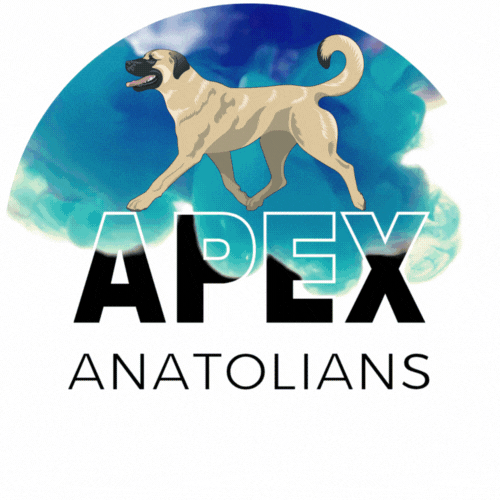Blog Posts
Upcoming 2026 Litter Plans
Breeding Anatolian Shepherd Dogs is a great responsibility that Apex Anatolians takes seriously. Here are our plans for 2026 as of December 2025.
All About Heat Cycles
Anyone who owns an intact female dog is likely familiar with the signs and symptoms of estrus (or “heat cycle”) in their girl. It typically starts with a swollen vulva, then red discharge, and some behavioral changes. Pro Tip: If you’re not sure, use a plain…
2024: A Year in Review
Working Dog Our dogs are first and foremost working guardians. They live with our livestock, protecting them from the various apex predators we have sniffing around our delicious critters! You can see regular working photos in our instagram feed. Show Ring Highlights…
The Shedding Truth
Anatolian Shepherd Dogs shed, whether they are working outdoors 24/7 or living with you in your home. You can expect to be cleaning up clouds of undercoat and guard hair at least once, but usually twice each year in the Spring/Summer and again in the Fall to make room…
Demir x Xena 2024 Litter
Xena blessed us with 4 beautiful little puppies on November 27th, 2024. Two males and two females, this smaller litter is thriving and getting plenty of food! Rowan, Male, Brindle Black Mask Forrest, Male, Fawn Black Mask Maple, Female, Fawn Pinto Ash, Female, Brindle…
Nutrition Focus – Ca:P and Protein
https://youtu.be/xnBxaw65sK0 What food does the Apex Pack eat? Puppies <24 months: Muenster 26/18 Adults >24 months: Muenster 30/20 Easy keepers (put on too much weight on Adult food): Muenster 26/18Video Transcript:Nutrition. Yay. So every dog needs to eat. It…
SportDog Invisible Fence
We have gotten a lot of questions about our fencing and how we keep our dogs contained. We have 47″ tall woven wire steel field fence that makes up our pens. The fence is perfectly adequate for our Kunekune pigs, hair sheep, Jersey cow, and puppies. However, our older…
NEW STUDY: LGDs Deter Grizzly Bears
Grizzly bear with a neighbor’s chicken run in our valley, March 27, 2024 There is a new multi-year study regarding how livestock guardian dogs deter grizzly bears in Montana. Two of our puppies were placed with a family in this recent LGD study by Utah State…
Shazam x Jyn Litter Announcement
Celebration! Today we celebrate a few firsts here at Apex Anatolians! Our first successful AI (artificial insemination, not intelligence) litter, first cesarean section, and first mini litter (2 pups) all happened today! Gratitude As many of my friends know, my mentor…
The Anatolian Shepherds and Dog Shows
GCHS Karaboudjan’s Mystic Moonspell “Shazam” with a “Best of Breed” ribbon. Owned and Bred by my mentor Janet Dotson of Karaboudjan Anatolians. Have you ever wondered why an Anatolian Shepherd dog goes to a dog show? And what does…
